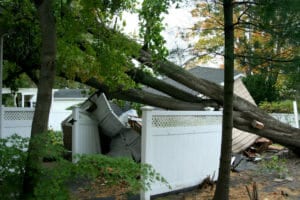Your Greensboro home insurance policy covers many things, some of which may seem confusing and require study and analysis to fully understand. To the question, “Does home insurance cover fallen trees?” the answer is, “It depends.” The reason the answer isn’t cut and dried is because coverage depends on the situation that has caused the tree to fall.
Your Greensboro home insurance policy covers your home and other outside structures such as detached garages, sheds and fences from damage caused by wind, lightning and hail – three perils that may cause tree damage. If an otherwise healthy tree damages your home as the result of a covered peril such as wind, lightning or hail, your homeowner’s policy will likely help pay for the repair of the covered structures. It should also pay for the replacement of any covered personal property damaged by the fallen tree(s). Removal of fallen tree debris should be covered if the tree hits an insured structure. Claim amounts are usually capped at between $500-$1,000.
When Your Insurance Probably Won’t Pay
If a fallen tree is the victim of negligence or some maintenance related issue, has become rotten or is otherwise ready to fall down, it’s likely not covered should the wind blow it down.
If a fallen tree causes no damage to your home or other covered structures on your property, your home insurance probably won’t pay for cleanup or debris removal. If it has become an obstacle to cars, such as driveway blockage, or impeding a handicap ramp, your policy may help pay for the cost of removal.
If a storm causes a healthy tree on your property to fall on and damage your neighbor’s property, your insurance likely won’t come into play. The neighbor who’s suffered the damage will be expected to make a claim with his or her own insurance carrier. If a neighbor’s tree falls and damages your property, the reverse holds and you’ll be expected to file a claim with your insurer. Your insurance company may try to collect money from the neighbor’s insurer (called subrogation). If this process succeeds, your insurer may reimburse you for your deductible.
During a serious storm, trees, limbs and branches can often be blown a significant distance and end up damaging your property. This damage will probably be covered without the need to determine where the damaging tree or tree parts originated.

